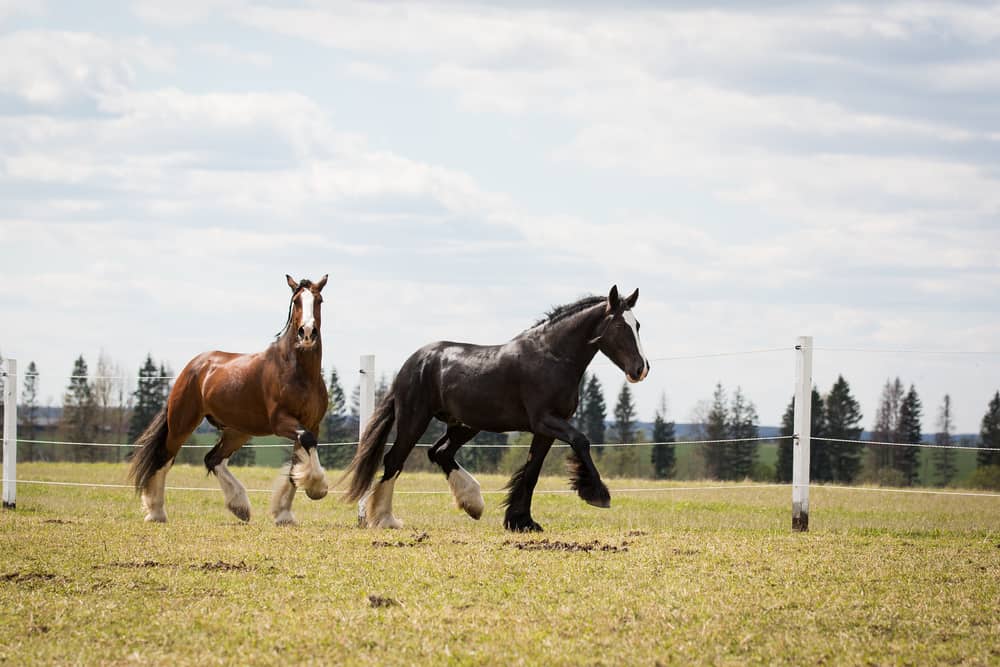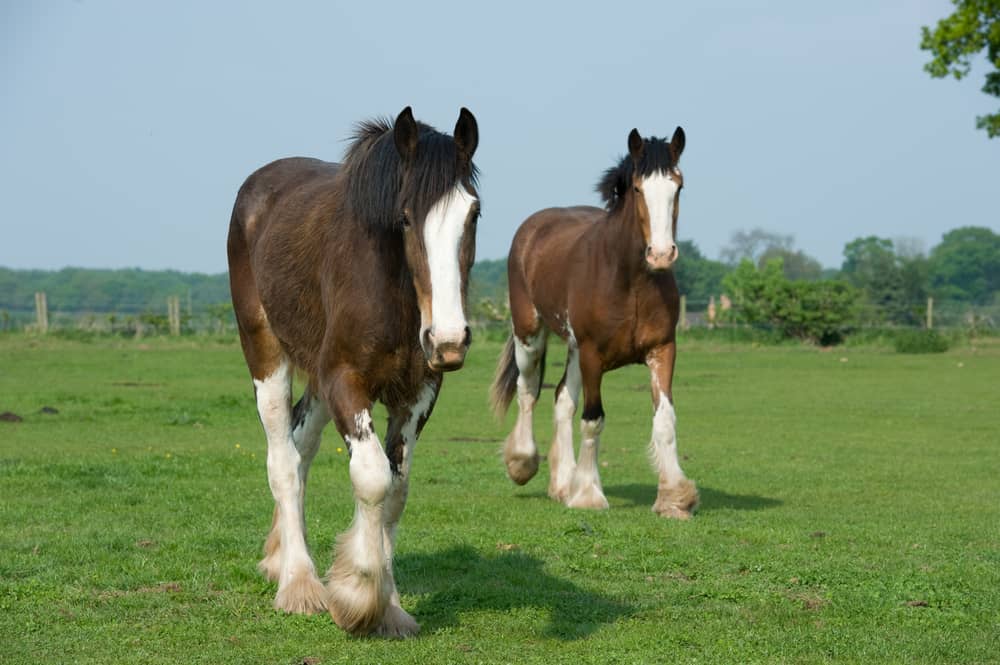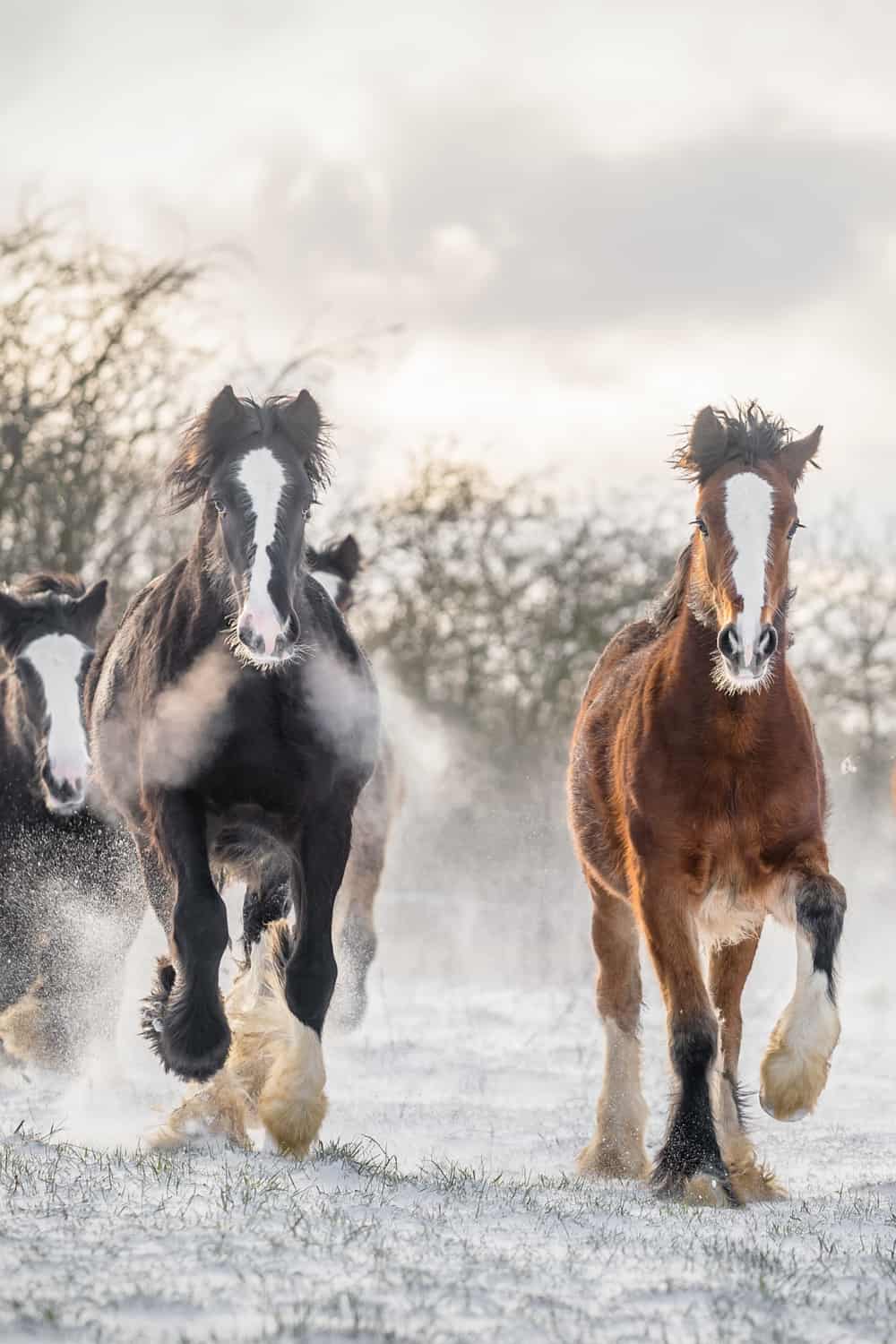Shires and Clydesdales are two of the most popular horse breeds.
At first glance, they look surprisingly alike. But, there are some distinctive differences between the two equines.
I have owned both horses, and in this article, I will explain the difference between Shire vs. Clydesdale horse breeds.
Let’s get started!
What’s the Difference Between Shire vs. Clydesdale?
The main difference between a Shire and Clydesdale is their origin. Shires originated from Britain, while Clydesdale came from Scotland. Also, Shires have a thicker build, are taller, and have longer coats than Clydesdales.
Let’s take a look at the differences between Shire vs. Clydesdale in more detail.
History
Shires and Clydesdale share some history, but their origins are starkly different.
Clydesdales originated from Clydesdale county in Scotland, now known as Lanarkshire.
These equines were first bred in 1826 as drought horses, thanks to their heavy build and eagerness to follow instructions.
The Shire breed came about much earlier, dating as far back as 1066. They, too, were used as farm animals for their heavy-set bodies and strong work ethic.
Shires were popular and were exported in large numbers to various parts of the world, including Australia, New Zealand, Canada, and the United States.
By the 1960s, the Shire population had dwindled drastically. Breeders crossbred the few remaining Shires with Clydesdales to increase the population.
This is the reason why Shires and Clydesdale have similar appearances.
Physical Traits
Despite their strikingly similar looks, there are subtle differences between Shires and Clydesdales.
Both horse breeds have large, muscular, and strong bodies. But, Shires are bigger; they stand at 17 hands and weigh between 1,800 and 2,400 pounds.
Clydesdales are not small horses but have a slightly smaller frame when compared to Shires. Their height is about 16 to 17 hands with an average weight of 1,600 to 2,300 pounds.
Clydesdales have leaner and more refined muscles than a Shire’s, which are thick and dominant. Both breeds have feathered legs and hooves.
Clydesdales have a slightly arched neck and shoulders, a short, muscular back, deep chest, short, strong legs, and rounded hooves.
The Shire will have an equally short back and moderately arched neck. Its shoulders and chest are deep, but its legs are longer and more muscular, with large hooves.
Shires have long slim heads with a large muzzle and equally big eyes. In contrast, Clydesdales have a wider header, wide eyes, and a flat face. Typically, Shires feature their natural tail while Clydesdales will have their tails docked.
When it comes to the coat color, Shires tend to be black, brown, grey, and sometimes chestnut. Most Clydesdales are black, brown, roan, or bay.
Both breeds can have white markings on their face, body, and legs, but these are more common in Clydesdales. In fact, breeders and owners prefer Shires with no white markings.
Personality
Shires and Clydesdales have quite different temperaments. Both are mild-mannered, one of the reasons they were kept as drought animals for centuries.
Shires are noticeably more obedient, willing to follow instructions, and have a strong work ethic. Their laid-back personality and eagerness to please make them the ideal horse for new riders.
Shires can still be used for farm work and other field jobs. But, more recently, they are a popular choice for riding because they are among the easiest horse breeds to train.
Clydesdales are sometimes referred to as ‘cold-blooded.’ Not because they are related to reptiles by any chance but because of their cool and gentle demeanor.
Still, Clydesdales are energetic and playful while maintaining admirable level-headedness. They make the perfect choice for a work animal and a riding companion.
Uses
Shires and Clydesdales have historically been used as work animals. Farm owners and ranchers used them for plowing, pulling carts, logging, and as means of transport.
Both breeds are at their best when they have work to do. But, these days, most owners keep these horses for their riding pleasure and shows.
The two horses are physically attractive. Owners take pride in showing off their equines, especially the feathered legs, which are prominent on both horses.
The Shire population is running out fast. The breed is considered an endangered species. Indeed, it is becoming rarer to spot Shires in racing tracks and shows today.
Clydesdales are still used as workhorses in some parts of Britain, the United States, Australia, and New Zealand. But, for the most part, you will find Clydesdales proudly displayed in shows and farms for riding and companionship.
Maintenance
Shires and Clydesdales are generally healthy breeds and don’t require much in the way of care, grooming, and general maintenance.
Still, both are prone to some genetic diseases unique to their breed.
Shires are susceptible to a disease known as polysaccharide storage myopathy, a neuromuscular disease that causes inflammation in the hind legs. A high-fat diet can minimize the chances of this disease in your horse.
Similarly, Clydesdales are prone to a chronic illness known as progressive lymphedema. This disease causes the limbs to swell, subjecting the horse to a great deal of pain.
Both horse breeds have feathered legs and hooves. The feathers give the horses an extra cuteness factor, but regular care and maintenance are necessary.
Be sure to keep the horses’ feathers and hooves clean at all times. Debris, feces, and other dirt caught in the feathers can cause itching and breed disease-causing bacteria.
Which One Should You Choose: Shire Vs Clydesdale Horse Breeds?
Shires and Clydesdales are more similar than they are different. Both are great choices, whether you are looking for a riding, show, or workhorse.
Both breeds don’t do too well with boredom. They prefer when they have work to do, making them an excellent choice if you are looking for a breed with a consistently strong work ethic.
Their laid-back personality makes the two-horse breeds good with children and other pets in your household.
Shires and Clydesdales generally make for good riders. They are both well-behaved and are less prone to aggressive or unexpected behavior. If you want a horse you can teach new tricks, these two breeds are good choices.
When deciding which one to choose between a Shire and Clydesdale, your decision will likely come down to the physical looks.
Shires have thicker coats and generally come in solid colors with few or no white markings. If you prefer the white marking and a predominantly white coat, a Clydesdale might be better.
Keep in mind that Shires and Clydesdales have a shorter lifespan compared to other horse breeds. While other breeds can live for up to 30 years, the average lifespan of draft horses is 20 years.
Both horses are susceptible to health issues, but these can be managed with proper care and maintenance.
Now that you know the differences between Shire vs. Clydesdale let’s answer some common questions that usually come up about these horse breeds.
Frequently Asked Questions
Are Shires and Clydesdale the same breed?
Clydesdales and Shires are different breeds of horses, but they fall under the same category of draft horses. The main difference between these breeds is their origin. Clydesdales trace their origins to Scotland, while Shires originate from England. Clydesdales are typically shorter and leaner compared to Shires.
Which is one is better, Shire or Clydesdale?
Shires and Clydesdales are different breeds, but they share some stark similarities. Both are strong horses with great work ethics. Their personality is also quite similar—Shires and Clydesdales are easy-going with a mild temperament and chill attitude. They are easy to train, obedient, and generally get along well with other pets. Both breeds are great choices if you want to add an equine companion to your farm.
How can you tell the Shire from a Clydesdale?
Their coloring is the best way to distinguish a Shire horse from a Clydesdale. As a general rule, Shires come in a solid color, sometimes with white markings on the face and legs. Clydesdales have large white markings all over their body.
Summary: Shire vs. Clydesdale Horse Breeds
Shire and Clydesdales share many similarities and subtle differences physically and personality-wise.
Generally, Shires are slightly larger and taller than Clydesdales. Clydesdales are slightly slimmer and leaner than Shires. However, to the untrained eye, the structure of both horses is quite similar.
In terms of personality, Clydesdales and Shire are incredibly similar. They are both easy-going, friendly, and eager to please their owner. Clydesdales tend to be more agile and playful, while Shires are more chill and level-headed.












Good article but a couple of points:
1. Not “drought” horses but they are “draught” horses.
2. Near the start of the article, you state that Shires originated in Britain: should say “England” (since Scotland is also part of Britain). 🙂
“Shires originated from Britain, while Clydesdale came from Scotland.”
Scotland’s in Britain, mate.